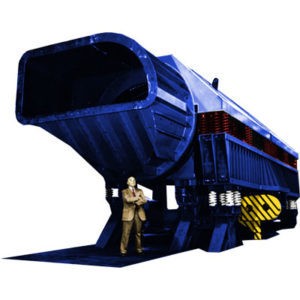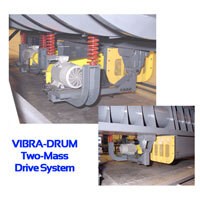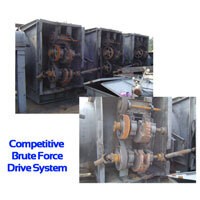Two-Mass vs. Brute Force Vibratory Drums
The differences explained
Vibrating drums are designed using two drive designs, direct drive and two-mass. General Kinematics has had decades of experience designing both types of drive configurations, and is the exclusive manufacturer of two-mass vibratory foundry drums, and holds numerous patents on this technology. Experience has shown two-mass vibratory drums out-perform direct drive designs in all sizes and applications.
While the principles behind both brute force and two-mass vibrating drums are similar, the physics involved in each are significantly different. General Kinematics has over 100 VIBRA-DRUM® installations world-wide in many of the leading metal casting facilities, and is proud to offer you this information in helping you select the best solution for your process.
Please reference the following technical differences below:
VIBRA-DRUM® Two-Mass Vibratory Drums:
Two-Mass System:
Two-Mass refers to a style of vibratory equipment where one mass (an exciter) is used to drive a second mass (drum body). The exciter mass typically contains a motor and is connected to a trough using a combination of springs. When the two mass system operates, it requires much less horsepower and provides the ability for accurate unit stroke under varying material loads, versus a single mass (brute force) system which has a direct ratio of horsepower to material mass. By applying two mass technique, the VIBRA-DRUM® reduces energy costs and horsepower requirements by a factor of up to 5.
Upset conditions:
The two-mass, sub resonant tuned system of the VIBRA-DRUM® is designed to compensate for variations in load size and weight.
Springs:
GK vibratory springs are designed for 24/7 continuous duty, and require little to no maintenance over the life of the machine. GK heavy-duty springs do not break or wear out under normal operating conditions.
Parts:
The natural frequency design requires few moving parts. Maintenance is contained to lubrication and monitoring of motor and drive components.
Drive Force:
Natural frequency vibration of the VIBRA-DRUM® produces a beneficial rotary drum-like motion that quickly reduces sand lumps without casting damage. High frequency agitation efficiently reduces sand to original grain size. The tumbling action of the VIBRA-DRUM® scrubs the casting surfaces without castings sustaining damage.
DIRECT DRIVE BARRELS:
Direct Drive System:
Vibratory assemblies are attached directly to the side of the barrel of the drum and use rotating eccentric weights to drive the barrels motion. For smaller sized drums, vibratory motors can be directly attached to the drum body. For larger capacity systems, an elaborate system of eccentric weights, drive shafts, and large (and expensive) bearings must be used to generate enough force to move the assembly.
Upset Conditions:
Unlike natural frequency drums, brute force drums cannot automatically compensate for overload conditions without a manual adjustment of the counterweight assemblies. When the direct drive drum exceeds its tuned design capacity, conveyance is lost, jamming occurs, and the machine ceases effective operation.
Parts / Drive Design:
Brute force drums have significantly more moving parts to enable their operation, increasing maintenance costs and the chance of drive failure. This adds to the overall lifetime cost of ownership significantly. Further, having the drive directly connected to the body of the drum imparts significant stress into the body members, causing accelerated fatigue and failure. Brute force drives create a hammering effect on the metal structure, where two-mass units are more of a bouncing motion.
Drive force:
Brute force drums convey product with a forward drive motion which results in a positive conveying action, but reduced tumbling action. This reduces the efficiency and effectiveness in the cleaning of castings.




